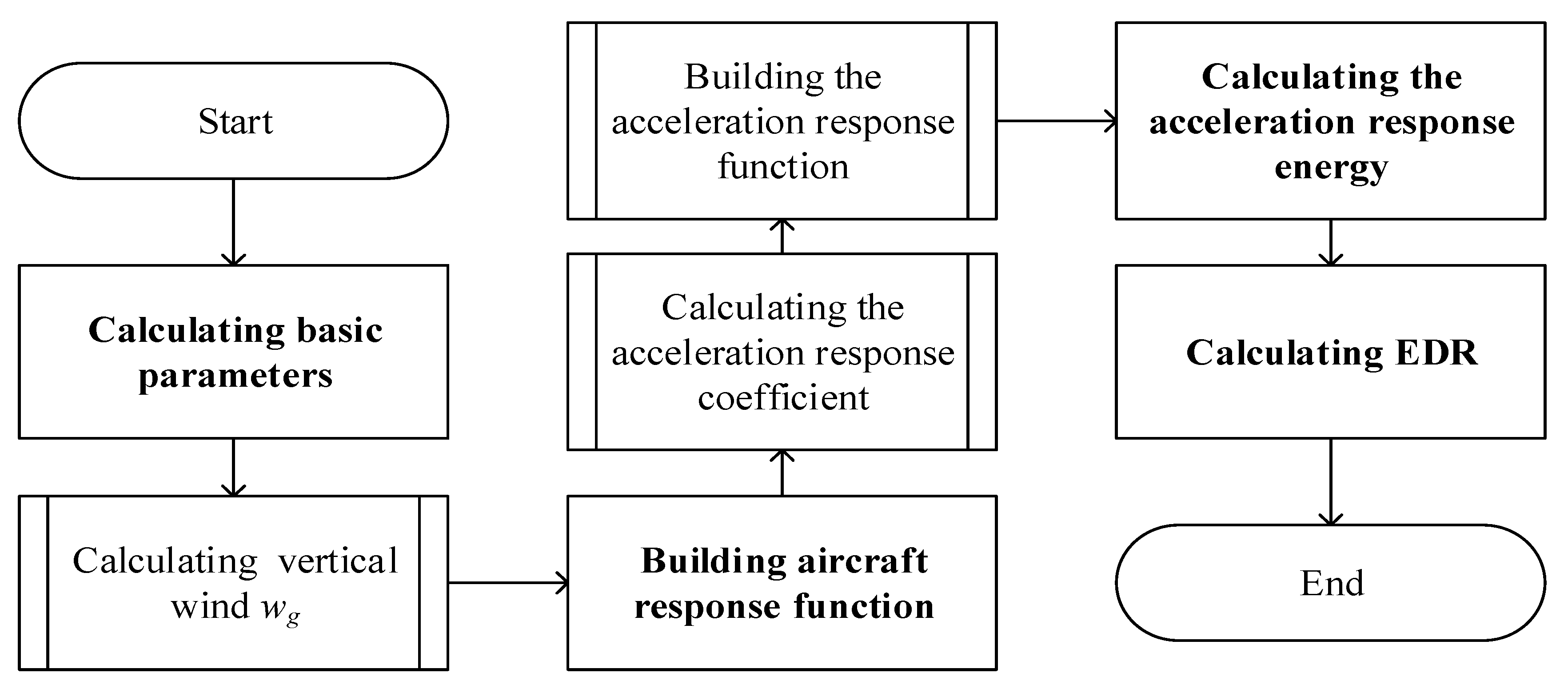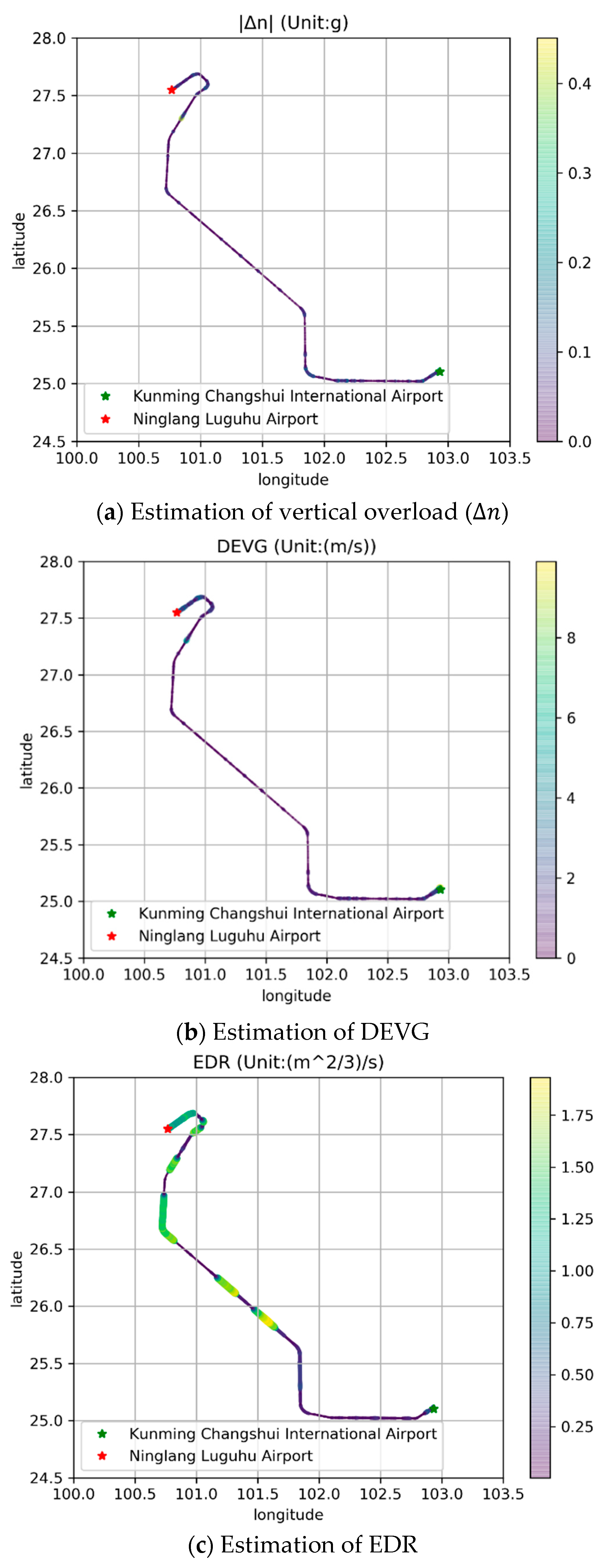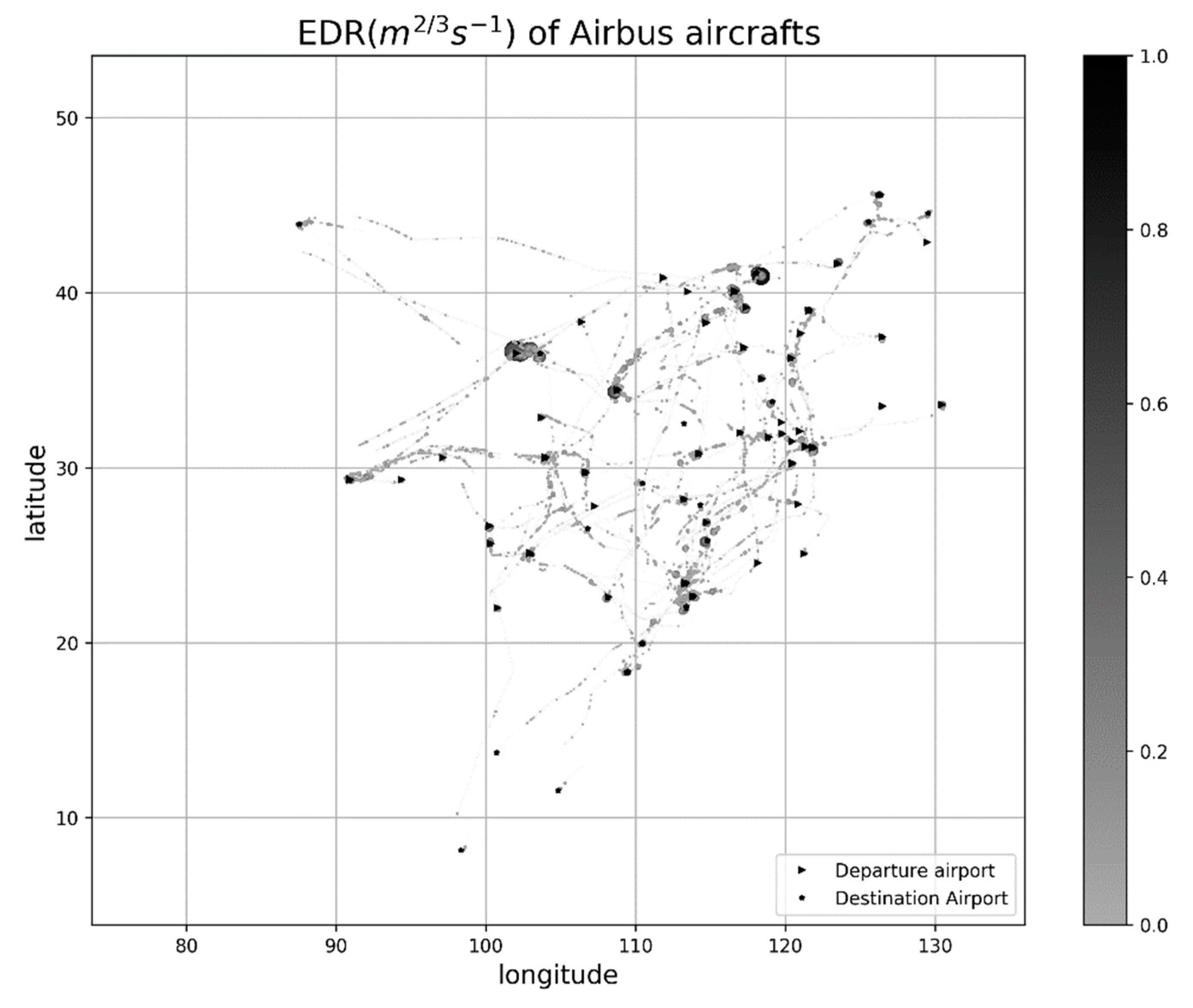Estimating Eddy Dissipation Rate with QAR Flight Big Data
Abstract
:1. Introduction
2. Data and Methodology
2.1. QAR Data
2.2. Air Turbulence Measurement
2.2.1. Vertical Overload
2.2.2. DEVG
2.3. EDR Estimation
2.3.1. The First Estimation Method
- Inverse Fourier transform of bandpass filter function, as show in Equation (10):
- Use the Parseval theorem (assuming local stationary) and then use the convolution theorem to get its approximation, as show in Equation (11):
2.3.2. The Second Estimation Method
2.3.3. Estimating EDR with QAR Data
- Estimate the basic parameter vertical wind .
- Build the aircraft response function.
- Estimate the acceleration response energy.
- Estimate EDR.
(1) Estimate Basic Parameters
(2) Build the Aircraft Response Function
(3) Estimate the Acceleration Response Energy
(4) Estimate EDR
3. Results and Discussion
4. Conclusions
Author Contributions
Funding
Acknowledgments
Conflicts of Interest
References
- Potter, E. Five Myths about Air Turbulence. USA Today. Available online: https://www.usatoday.com/story/travel/flights/2014/07/10/5-myths-about-air-turbulence/12301043/ (accessed on 10 July 2014).
- Lallanilla, M. Air Turbulence: How Dangerous Is It? Live Science. Available online: https://www.livescience.com/43448-air-turbulence-dangerous-injuries.html (accessed on 18 February 2014).
- Fultz, A.J.; Ashley, W.S. Fatal weather-related general aviation accidents in the united states. Phys. Geogr. 2016, 37, 291–312. [Google Scholar] [CrossRef]
- Dutton, J.A.; Panofsky, H.A. Clear air turbulence: A mystery may be unfolding. Science 1970, 167, 937. [Google Scholar] [CrossRef] [PubMed]
- Ellrod, G.; Knapp, D. An Objective Clear-Air Turbulence Forecasting Technique: Verification and Operational Use. Weather Forecast. 1992, 7, 150–165. [Google Scholar] [CrossRef]
- Cornman, L.B.; Morse, C.S.; Cunning, G. Real-time estimation of atmospheric turbulence severity from in-situ aircraft measurements. J. Aircr. 1995, 32, 171–177. [Google Scholar] [CrossRef]
- Wu, Y.; Zhou, L.; Liu, K.; Huang, C.; Shu, Z. AMDAR based statistical analysis on the features of cross-ocean airplane turbulence over china’s surrounding sea areas. J. Meteorol. Sci. 2014, 34, 17–24. [Google Scholar]
- WMO. Aircraft Meteorological Data Relay (AMDAR) Reference Manual; World Meteorological Organization: Geneva, Switzerland, 2003. [Google Scholar]
- Markatos, N.C. The mathematical modelling of turbulent flows. Appl. Math. Model. 1986, 10, 190–220. [Google Scholar] [CrossRef]
- Argyropoulos, C.D.; Markatos, N.C. Recent advances on the numerical modelling of turbulent flows. Appl. Math. Model. 2015, 39, 693–732. [Google Scholar] [CrossRef]
- Kundu, P.K.; Cohen, I.M.; Dowling, D.R. Fluid Mechanics, 5th ed.; Elsevier: London, UK, 2012. [Google Scholar]
- Spalding, D.B. A general purpose computer program for multi-dimensional one- and two-phase flow. Math. Comput. Simul. 1981, 23, 267–276. [Google Scholar] [CrossRef]
- Spalart, P.R. Detached-Eddy Simulation. Annu. Rev. Fluid Mech. 2008, 41, 181–202. [Google Scholar] [CrossRef]
- Launder, B.E.; Spalding, D.B. Mathematical Models of Turbulence; Academic Press: London, UK, 1972. [Google Scholar]
- Bradshaw, P. An Introduction to Turbulence and its Measurements; Pergamon: Oxford, UK, 1971. [Google Scholar]
- Launder, B.E. Heat and mass transport. In Topics in Applied Physics; Bradshaw, P., Ed.; Springer: Berlin, Germany, 1978; Volume 12, pp. 231–287. [Google Scholar]
- Sarpkaya, T.; Robins, R.E.; Delisi, D.P. Wake-Vortex Eddy-Dissipation Model Predictions Compared with Observations. J. Aircr. 2001, 38, 687–692. [Google Scholar] [CrossRef]
- Chan, P.W. Generation of an Eddy Dissipation Rate Map at the Hong Kong International Airport Based on Doppler Lidar Data. J. Atmos. Ocean. Technol. 2010, 28, 37–49. [Google Scholar] [CrossRef]
- Proctor, F.; Hamilton, D. Evaluation of Fast-Time Wake Vortex Prediction Models. In Proceedings of the 47th AIAA Aerospace Sciences Meeting including the New Horizons Forum and Aerospace Exposition, Orlando, FL, USA, 5–8 January 2009; American Institute of Aeronautics and Astronautics: Reston, VA, USA, 2009. [Google Scholar] [CrossRef]
- MacCready, P.B. Standardization of gustiness values from aircraft. J. Appl. Meteorol. 1964, 3, 439–449. [Google Scholar] [CrossRef]
- Sharman, R.D.; Pearson, J.M. Prediction of energy dissipation rates for aviation turbulence. Part i: Forecasting nonconvective turbulence. J. Appl. Meteorol. Climatol. 2016, 56, 317–337. [Google Scholar] [CrossRef]
- Zhou, Y.; Wei, M.; Cheng, Z.; Ning, Y.; Qi, L. The wind and temperature information of AMDAR data applying to the analysis of severe weather nowcasting of airport. In Proceedings of the IEEE Third International Conference on Information Science and Technology, Yangzhou, China, 23–25 March 2013. [Google Scholar]
- Sun, H.; Jiao, Y.; Han, J.; Wang, C. A novel temporal-spatial analysis system for QAR big data. In Proceedings of the IEEE 17th International Conference on Communication Technology (ICCT), Chengdu, China, 27–30 October 2017; pp. 1238–1241. [Google Scholar]
- Sun, J.; Lenschow, D.H.; Burns, S.P.; Banta, R.M.; Newsom, R.K.; Coulter, R.; Frasier, S.; Ince, T.; Nappo, C.; Balsley, B.B.; et al. Atmospheric disturbances that generate intermittent turbulence in nocturnal boundary layers. Bound. Layer Meteorol. 2004, 110, 255–279. [Google Scholar] [CrossRef]
- Sherman, D.J. The Australian Implementation of AMDAR/ACARS and the Use of Derived Equivalent Gust Velocity as a Turbulence Indicator; Department of Defence, Defence Science and Technology Organisation, Aeronautical Research Laboratories Melbourne: Melbourne, Australia, 1985.
- Haverdings, H.; Chan, P.W. Quick access recorder data analysis software for windshear and turbulence studies. J. Aircr. 2010, 47, 1443–1447. [Google Scholar] [CrossRef]
- Yuan, J. Application research on aircraft air bump level classification standard. Sci. Technol. 2017, 7, 246. [Google Scholar]
- SWMO. Aircraft Meteorological Data Relay (AMDAR) Reference Manual; SWMO, Ed.; SWMO: Geneva, Switzerland, 2003. [Google Scholar]
- Truscott, B. EUMETNET AMDAR AAA AMDAR SOFTWARE Developments—Technical Specification; Doc. Ref.; Met Office: Exeter, UK, 2000.
- Gill, P.G. Objective verification of world area forecast centre clear air turbulence forecasts. Meteorol. Appl. 2014, 21, 3–11. [Google Scholar] [CrossRef]
- Kim, S.-H.; Chun, H.-Y.; Chan, P.W. Comparison of turbulence indicators obtained from in situ flight data. J. Appl. Meteorol. Climatol. 2017, 56, 1609–1623. [Google Scholar] [CrossRef]
- Sharman, R.D.; Cornman, L.B.; Meymaris, G.; Pearson, J.; Farrar, T. Description and derived climatologies of automated in situ eddy-dissipation-rate reports of atmospheric turbulence. J. Appl. Meteorol. Climatol. 2014, 53, 1416–1432. [Google Scholar] [CrossRef]
- Cornman, L.; Meymaris, G.; Limber, M. An update on the FAA aviation weather research programs in situ turbulence measurement and reporting system. In Proceedings of the 11th Conference on Aviation, Range, and Aerospace Meteorology, Hyannis, MA, USA, 5 October 2004. [Google Scholar]
- Bach, R.E.; Wingrove, R.C. Applications of state estimation in aircraft flight-data analysis. J. Aircr. 1985, 22, 547–554. [Google Scholar] [CrossRef]
- Wu, M.; Sun, H.; Wang, C.; Lu, B. Detecting and Analysing Spatial-Temporal Aggregation of Flight Turbulence with the QAR Big Data. In Proceedings of the 2018 26th International Conference on Geoinformatics, Kunming, China, 28–30 June 2018; pp. 1–6. [Google Scholar]
- Brunsdon, C.; Fotheringham, A.S.; Charlton, M.E. Geographically Weighted Regression: A Method for Exploring Spatial Nonstationarity. Geogr. Anal. 1996, 28, 281–298. [Google Scholar] [CrossRef]
- Lu, B.; Harris, P.; Charlton, M.; Brunsdon, C. The GWmodel R package: Further topics for exploring spatial heterogeneity using geographically weighted models. Geo-Spat. Inf. Sci. 2014, 17, 85–101. [Google Scholar] [CrossRef]





| Turbulence Indicator | ||||||||
|---|---|---|---|---|---|---|---|---|
| <0.1 | 0.1–0.2 | 0.2–0.3 | 0.3–0.4 | 0.4–0.5 | 0.5–0.8 | >0.8 | ||
| Turbulence mean EDR () | <0.1 | 0 | 1 | 3 | 6 | 10 | 15 | 21 |
| 0.1–0.2 | 2 | 4 | 7 | 11 | 16 | 22 | ||
| 0.2–0.3 | 5 | 8 | 12 | 17 | 23 | |||
| 0.3–0.4 | 9 | 13 | 18 | 24 | ||||
| 0.4–0.5 | 14 | 19 | 25 | |||||
| 0.5–0.8 | 20 | 26 | ||||||
| >0.8 | 27 | |||||||
| Turbulence intensity | steady flight | weak turbulence | moderate turbulence | strong turbulence | ||||
| UTC_MIN_SEC | IAS | VRTG | RALT | PITCH | IVV | ROLL | AOAL | AOAR | MACH | LATP | LONP | WIN_SPD | WIN_DIR |
|---|---|---|---|---|---|---|---|---|---|---|---|---|---|
| 0:20:24 | 142 | 1.004 | 1139 | 3.9 | −921 | 0 | 19.3 | 0 | 0.285 | 29.3847 | 100.034 | 15 | 198.3 |
| 0:20:25 | 142 | 0.984 | 1133 | 3.9 | −892 | 0 | 19.3 | 0 | 0.284 | 29.384 | 100.0346 | 16 | 197.6 |
| 0:20:26 | 142 | 0.984 | 1120 | 3.9 | −864 | 0 | 19.3 | 0 | 0.283 | 29.3833 | 100.0346 | 16 | 197.6 |
| 0:20:27 | 142 | 0.977 | 1112 | 3.9 | −870 | −0.35 | 19 | 0 | 0.284 | 29.3826 | 100.0346 | 16 | 197.6 |
| 0:20:28 | 142 | 0.949 | 1102 | 3.9 | −896 | −0.35 | 18.6 | 0 | 0.284 | 29.3819 | 100.0353 | 16 | 197.6 |
| 0:20:29 | 142 | 0.957 | 1097 | 3.9 | −917 | −0.35 | 19 | 0 | 0.283 | 29.3812 | 100.0353 | 17 | 199.7 |
| 0:20:30 | 141 | 0.965 | 1081 | 4.2 | −919 | 0 | 19.3 | 0 | 0.282 | 29.3802 | 100.0353 | 17 | 199.7 |
| 0:20:31 | 140 | 0.984 | 1038 | 4.2 | −909 | 0.35 | 19.3 | 0 | 0.281 | 29.3795 | 100.036 | 17 | 199.7 |
| 0:20:32 | 140 | 0.984 | 1012 | 4.2 | −901 | 0.35 | 19.7 | 0 | 0.28 | 29.3788 | 100.036 | 17 | 199.7 |
| Field Name | Interpretation | Unit |
|---|---|---|
| IAS | Indicated Airspeed | m/s |
| VRTG | Vertical acceleration | g |
| RALT | Radio altitude | feet |
| PITCH | Control column position | degree |
| IVV | Instantaneous lifting velocity | feet/min |
| ROLL | Control wheel position | degree |
| AOAL | Angle of attack left | degree |
| AOAR | Angle of attack right | degree |
| HEIGHT | Height | feet |
| MACH | Mach Number | - |
| LATP | Present Positon Latitude | degree |
| LONP | Present Position Longitude | degree |
| WIN_SPDR | Wind speed FMC | knot |
| WIN_DIR | Wind Direction computed | knot |
| Turbulence Intensity | Overload Increment Range (g) |
|---|---|
| steady flight | |
| weak turbulence | |
| moderate turbulence | |
| strong turbulence |
| Turbulence Intensity | |
|---|---|
| steady flight | |
| weak turbulence | |
| moderate turbulence | |
| strong turbulence |
© 2019 by the authors. Licensee MDPI, Basel, Switzerland. This article is an open access article distributed under the terms and conditions of the Creative Commons Attribution (CC BY) license (http://creativecommons.org/licenses/by/4.0/).
Share and Cite
Huang, R.; Sun, H.; Wu, C.; Wang, C.; Lu, B. Estimating Eddy Dissipation Rate with QAR Flight Big Data. Appl. Sci. 2019, 9, 5192. https://doi.org/10.3390/app9235192
Huang R, Sun H, Wu C, Wang C, Lu B. Estimating Eddy Dissipation Rate with QAR Flight Big Data. Applied Sciences. 2019; 9(23):5192. https://doi.org/10.3390/app9235192
Chicago/Turabian StyleHuang, Rongshun, Huabo Sun, Chen Wu, Chun Wang, and Binbin Lu. 2019. "Estimating Eddy Dissipation Rate with QAR Flight Big Data" Applied Sciences 9, no. 23: 5192. https://doi.org/10.3390/app9235192





